Discover 15 hidden attractions, cool sights, and unusual things to do in Greenwich (United States). Don't miss out on these must-see attractions: Bruce Museum of Arts and Science, Putnam Cottage, and Bush–Holley House. Also, be sure to include Stanwich Church in your itinerary.
Below, you can find the list of the most amazing places you should visit in Greenwich (Connecticut).
Table of Contents
Bruce Museum of Arts and Science

The Bruce Museum is a museum in downtown Greenwich, Connecticut with both art and natural history exhibition space. The Bruce's main building sits on a hill in a downtown park, and its tower can be easily seen by drivers passing by on Interstate 95. Permanent exhibits include minerals, area Native American history and culture, changes in the area landscape and environment by human activity, and dioramas of Connecticut woodland wildlife and birds. The museum hosts changing exhibitions of art, photography, natural history, science, history and culture.
A second location, the Bruce Museum Seaside Center, is maintained at Greenwich Point Park, focusing on beach-related exhibits, including a touch-tank. The museum also has a "Brucemobile" with exhibits in a traveling van for outreach education. The museum hosts frequent lectures, classes and social events.[1]
Address: 1 Museum Dr, 06830 Greenwich (Central Greenwich)
Putnam Cottage
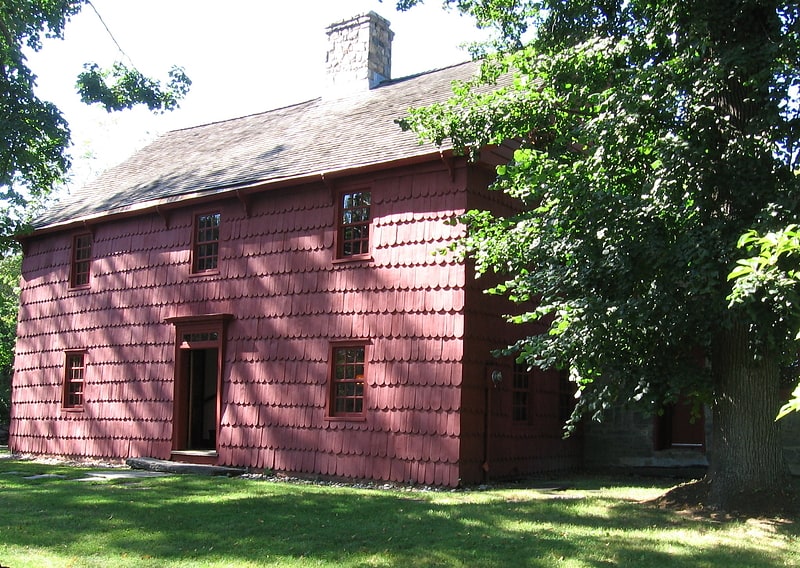
Historical landmark in Greenwich, Connecticut. Putnam Cottage was also known as Knapp Tavern during the American Revolution. It is located at 243 East Putnam Avenue, on the former route of the Boston Post Road, in Greenwich, Connecticut.[2]
Address: 243 E Putnam Ave, 06830-4808 Greenwich (Central Greenwich)
Bush–Holley House

Museum in Greenwich, Connecticut. The Bush–Holley House is a National Historic Landmark and historic house museum at 39 Strickland Road in the Cos Cob section of Greenwich, Connecticut. It was constructed circa 1730 and in the late nineteenth century was a boarding house and the center of the Cos Cob Art Colony, Connecticut's first art colony. From 1890 to 1920, the house was a gathering place for artists, writers and editors, and scores of art students came to study with leading American Impressionists John Henry Twachtman, J. Alden Weir, Theodore Robinson, and Childe Hassam. It is currently operated as a historic site by the Historical Society of the Town of Greenwich, and is open for tours.[3]
Stanwich Church
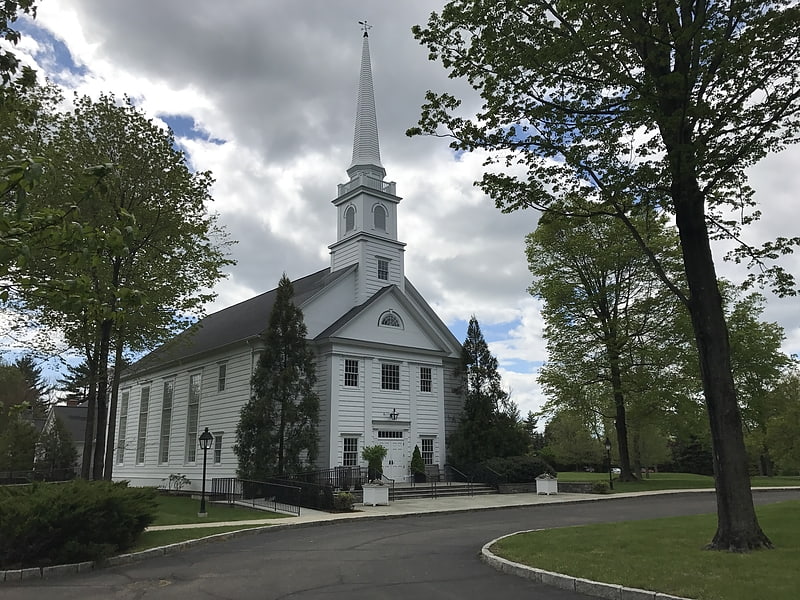
Stanwich Congregational Church is a nondenominational Christian church in Greenwich, Connecticut. It was founded in 1731. The congregation launched a second campus in Stamford, Connecticut, in 2014.[4]
Little Bethel African Methodist Episcopal Church

The Little Bethel African Methodist Episcopal Church, now the Bethel African Methodist Episcopal Church, is a historic church building and congregation at 44 Lake Avenue in Greenwich, Connecticut, United States. Founded in 1882, the congregation was Greenwich's first African-American congregation of any denomination, and remains a center of African-American society in the town. Its current church, built in 1921 on the site of its first church, is a good example of Late Gothic Revival architecture, and was listed on the National Register of Historic Places in 2010.[5]
Greenwich Library
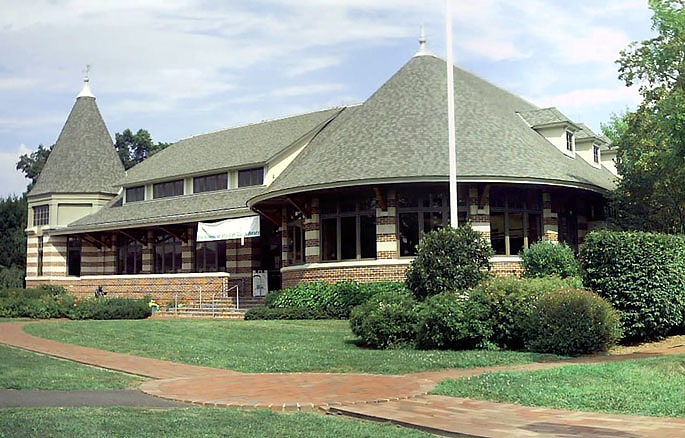
Main library. Greenwich Library is the main library in the Greenwich library system of Greenwich, Connecticut, United States. The Greenwich Library system consists of the Main Library and its Byram Shubert and Cos Cob branches.[6]
Address: 101 W Putnam Ave, Greenwich (Central Greenwich)
Greenwich Town Hall
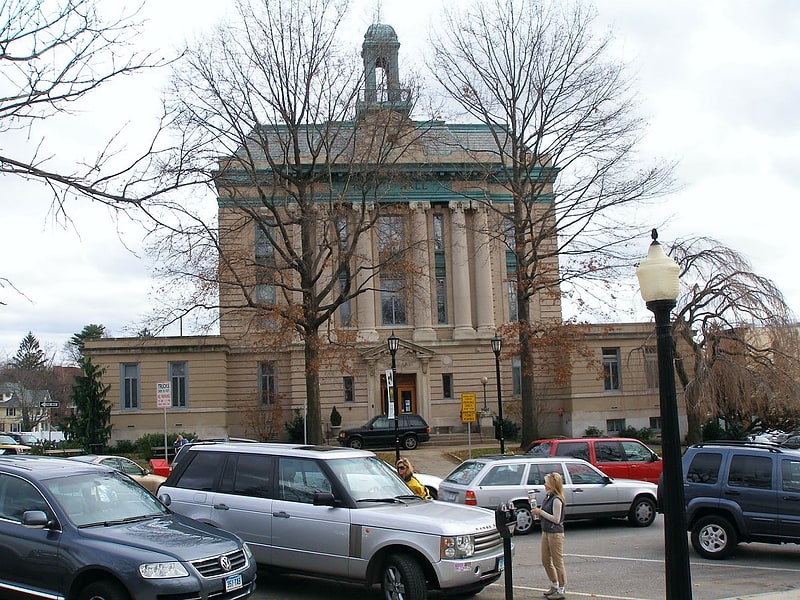
City or town hall in Greenwich, Connecticut. The Greenwich Senior Center, formerly Greenwich Town Hall, is a historic municipal building at 299 Greenwich Avenue in the business district of Greenwich, Connecticut. USA. Built in 1905, it is a prominent local example of Beaux Arts architecture, and served as the town's center of government until 1977. The building was added to the National Register of Historic Places on May 21, 1987.[7]
Address: 101 Field Point Rd, Greenwich (Central Greenwich)
St. Catherine of Sienna Church
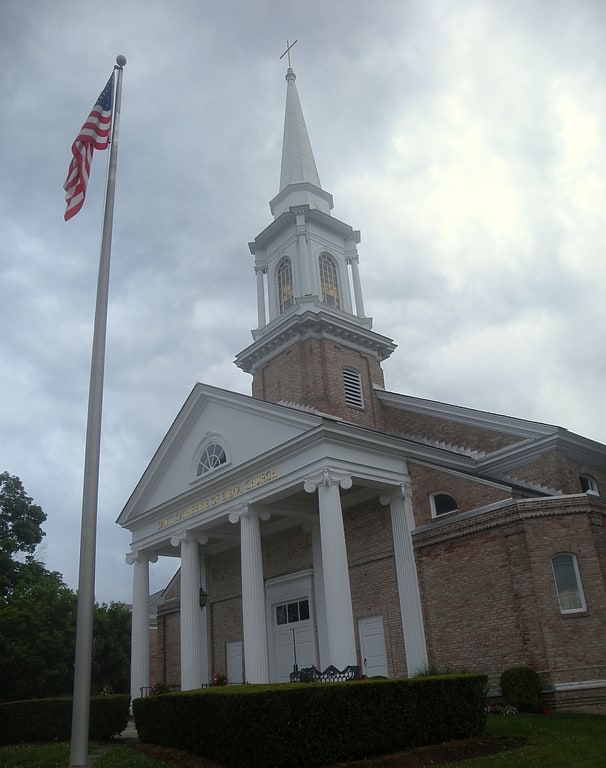
Catholic church in Greenwich, Connecticut. St. Catherine of Sienna is now part of The Parish of St. Catherine of Siena and St. Agnes, a Roman Catholic parish in Riverside & Greenwich, Connecticut, part of the Diocese of Bridgeport.[8]
Address: 4 Riverside Avenue, Greenwich
St. Roch Church
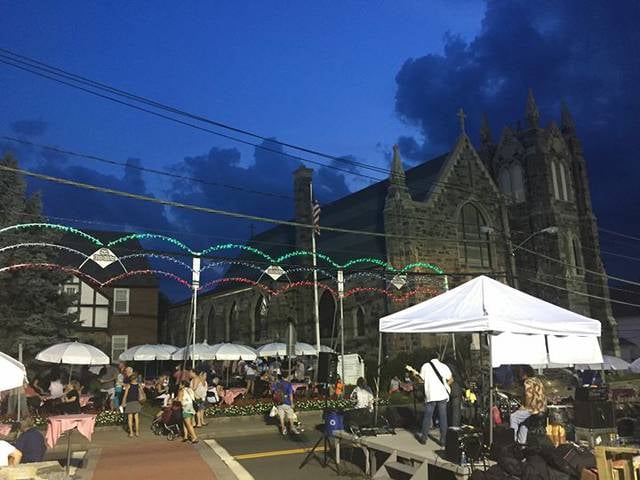
Catholic church in Greenwich, Connecticut. St. Roch is a Roman Catholic church in Greenwich, Connecticut, part of the Diocese of Bridgeport.
Although the Parish of St. Roch was formally established in 1938, it had been preceded by a mission church and it for this mission that the church was built. The large Romanesque Revival stone church was designed by noted architect Frank Urso of Stamford, CT who had designed the Norwalk Hotel in Bridgeport six years earlier. The church was built during the Great Depression and, according to ‘‘One Family in Faith a History of the Diocese of Bridgeport’’, a pastor of that period had acoustical tile installed in the sanctuary to muffle the nickels and dimes that came in for the construction of the church.[9]
Address: 10 St Roch Ave, 06830-6234 Greenwich (Central Greenwich)
Great Captain Island Light
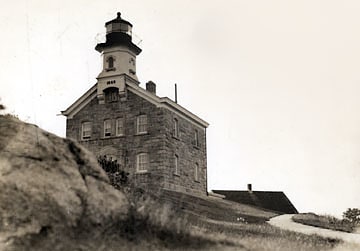
Lighthouse in Greenwich, Connecticut. Great Captain Island Lighthouse is a lighthouse on Great Captain Island in the western Long Island Sound off the coast of Greenwich, Connecticut, United States. Built in 1829, the first lighthouse, made of stone, was of such poor construction that the walls were severely cracked a decade later. In 1868, a new granite dwelling with attached lantern was completed. The lighthouse is of the same design as lighthouses at Sheffield Island in Norwalk; Morgan Point in Noank; Old Field Point Light and Plum Island in New York; and Block Island North in Rhode Island. In 1890, a fog whistle was added, in 1905 a siren was installed. The lighthouse was deactivated in 1970 when a skeletal tower replaced it. The Town of Greenwich acquired the property in 1973 and had full-time caretakers on the site until the lighthouse became too dilapidated in 2003. A successful restoration effort was completed in 2009 and a non-navigational light was activated in 2012. In 2010, a memorial plaque was installed to "honor the 23 people who lived in Greenwich, or had a connection to the town", who died in the September 11, 2001 attacks. In 1991, the Great Captain Island Light was added to the National Register of Historic Places.[10]
Byram School
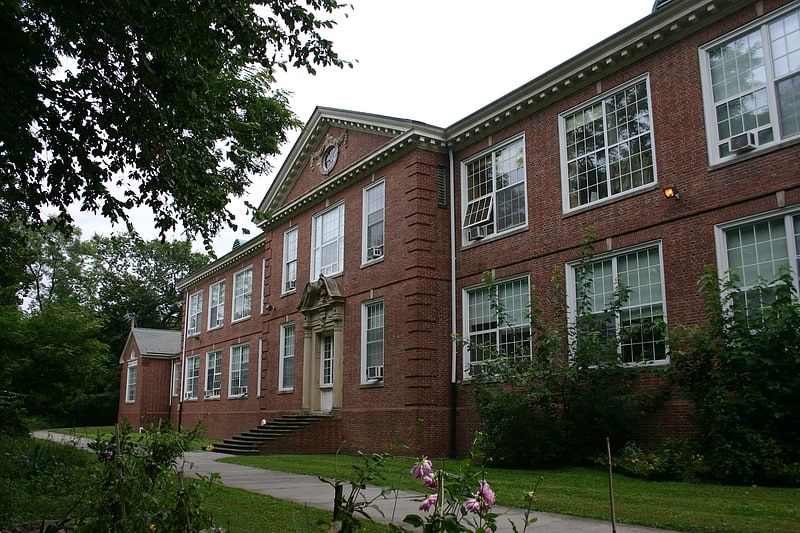
The Byram School is a historic former school building, located between Sherman Avenue and Western Junior Highway in Greenwich, Connecticut. Completed in 1926, it is a well-preserved example of institutional Colonial Revival architecture, enhanced by a parklike setting. It was used as a school until 1978, and was then converted to senior housing. The building was listed on the National Register of Historic Places on August 2, 1990.[11]
Riverside Avenue Bridge
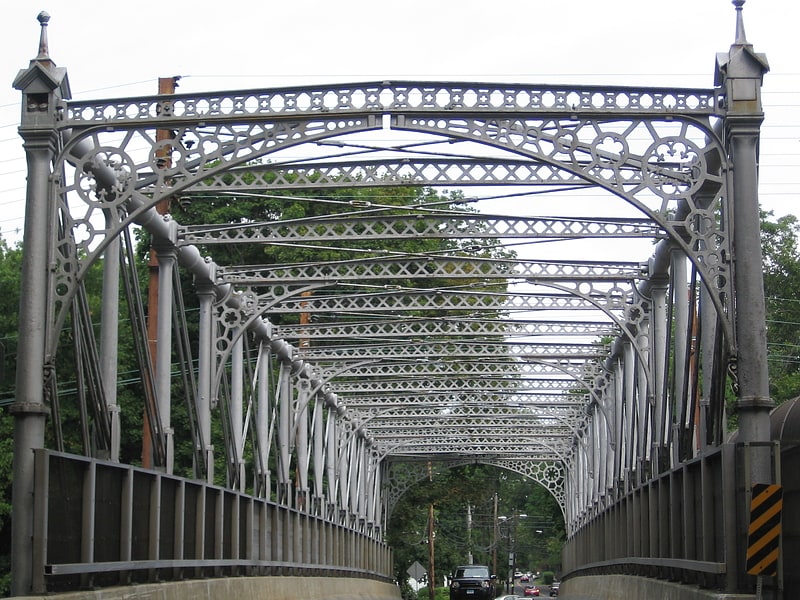
Bridge in Greenwich, Connecticut. The Riverside Avenue Bridge is the only cast-iron bridge in Connecticut and one of a small number still in use in the United States. It carries Riverside Avenue over the New Haven Line railroad tracks in the Riverside section of Greenwich, Connecticut. The bridge was part of an earlier span built in 1871 over the Housatonic River by the New York and New Haven Railroad, and when that bridge was replaced, part of it was erected in Riverside in 1895. It was placed on the National Register of Historic Places in 1977.
Called "an important engineering landmark" by Cultural Resource Management, a periodical published by the National Park Service, the bridge carries one of the primary streets in this section of town, and is owned by the Connecticut state government.[12]
Mianus River Railroad Bridge

Bridge in Greenwich, Connecticut. The Mianus River Railroad Bridge, also known as the Cos Cob Bridge, is a bascule drawbridge built in 1904 over the Mianus River, in Greenwich, Connecticut. It was listed on the National Register of Historic Places in 1987. The bridge carries the Northeast Corridor, the busiest rail line in the United States, both in terms of ridership and service frequency. It is operated by the Metro-North Railroad, successor to Conrail, Penn Central, and the New York, New Haven and Hartford Railroad, which erected it, and is owned by the Connecticut Department of Transportation.
It is a rolling lift type moveable bridge, and was prefabricated by the American Bridge Company, to replace a previous unsafe bridge on the site. It has a total length of 1,059 feet (323 m), divided into 11 spans. Seven of these are deck truss spans, while the others are deck girder spans, all set on stone abutments. The main movable span is 107 feet (33 m) long; four of the truss spans are 120 feet (37 m) in length.
It is one of eight moveable bridges on the Northeast Corridor through Connecticut surveyed in one multiple property study in 1986. The eight bridges from west to east are: this Mianus River Railroad Bridge, at Cos Cob, built in 1904; Norwalk River Railroad Bridge at South Norwalk, 1896; Saugatuck River Railroad Bridge at Westport, 1905; Pequonnock River Railroad Bridge at Bridgeport, 1902; Housatonic River Railroad Bridge, at Devon, 1905; Connecticut River Railroad Bridge, Old Saybrook-Old Lyme, 1907; Niantic River Bridge, East Lyme-Waterford, 1907; and Thames River Bridge (Amtrak), Groton, built in 1919. The Pequonnock River bridge—also on Metro-North's New Haven Line, as are the Norwalk, Westport, and Devon bridges—has since been replaced.[13]
St. Mary's Church

Catholic church in Greenwich, Connecticut. St. Mary is a Roman Catholic church in Greenwich, Connecticut, United States, part of the Diocese of Bridgeport.[14]
Feake-Ferris House
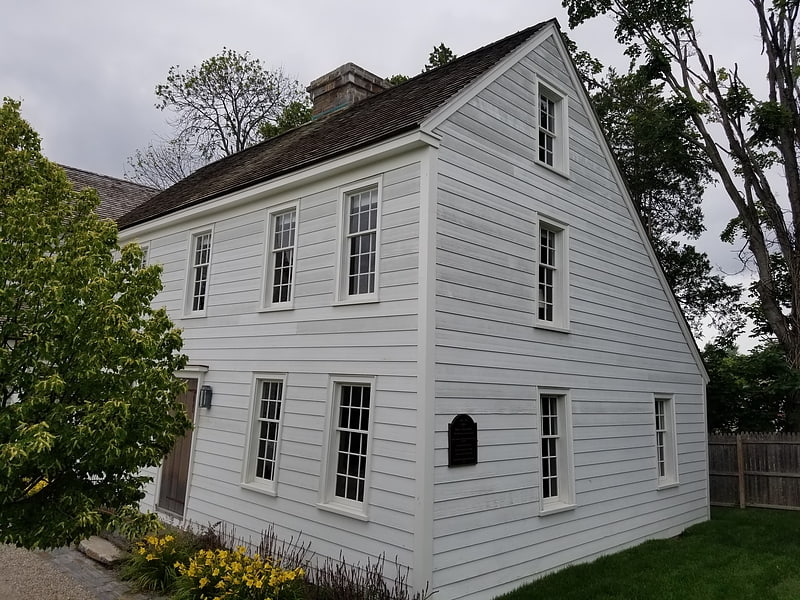
The Feake-Ferris House at 181 Shore Road in Greenwich, Connecticut was purportedly built around 1645 and was expanded over time to its present saltbox shape. The house was tested by dendrochronologists at Columbia University Lamont–Doherty Earth Observatory. The client, Greenwich Point Conservancy, has not yet released the results of the study, but claims that the west side of the house dates to circa 1645, the north lean-to addition made by Jeffrey Ferris to 1660, and the east side and expansion of the lean-to the James Ferris expansion of 1689. According to the Conservancy, as reported in Greenwich Free Press, the outermost rings of one summer beam dated to 1610, but due to the lack of sapwood in the sample, the precise date of the beam is unknown. Historian Missy Wolf researched the land's title history dating back to Feake.[15]